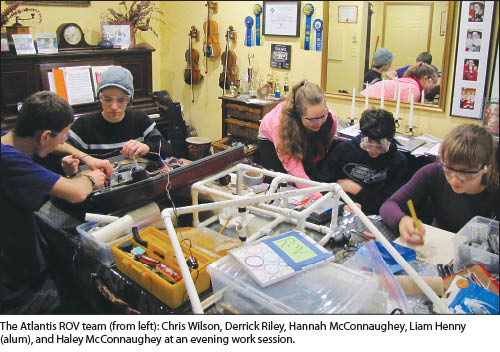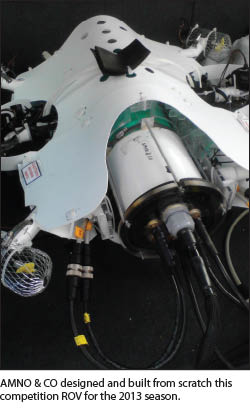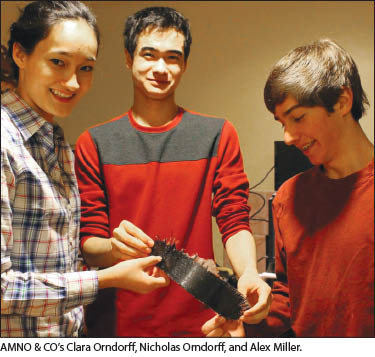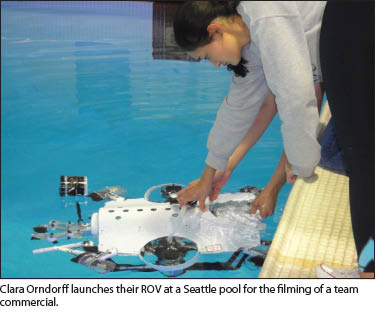Marine Advanced Technology Education is creating the future of marine surveying and operations from groups of innovative kids working around kitchen tables. Does it seem like those youngsters in the increasingly popular robotics clubs are having a lot of fun? Yes, but they’re doing something else, too.
Does it seem like those youngsters in the increasingly popular robotics clubs are having a lot of fun? Yes, but they’re doing something else, too.
The boom in robotics clubs, and especially underwater robotics, is no accident or fad. It is a concerted effort in Science, Technology, Engineering, and Math (STEM) education that has been fostered by an unprecedented cooperative of industry and academia to build the future workforce. This is a successful initiative that other geospatial professions and industries should pay close attention to.
Marine Advanced Technology Education (MATE) sets the groundwork for local remotely operated vehicle (ROV) clubs to do much more than simply “tinker with robots.” The kids in the clubs learn how to teach themselves and how to learn through engineering design and invention, and they learn how to write business plans and develop solutions for real-world problems.
Featured prominently on the marinetech.org website is MATE’s mission: “to provide the marine technical workforce with appropriately educated workers and to use marine technology to create interest in and improve STEM education.” Drill deeper into the website and you will see an impressive list of sponsors—public, private, defense-related, scientific, and environmental—all with succession-planning challenges.  As one young ROV team member noted, “At the competition, these [industry people] tell us that they find a lot of [job candidates] with a lot of theory and book learning, but they need [job candidates] that have experience building and running ROVs.” MATE arranges internships, puts on workshops and seminars, posts job listings, and develops and promotes curriculum for schools, but it is the hosting of youth ROV competitions that may have the most impact.
As one young ROV team member noted, “At the competition, these [industry people] tell us that they find a lot of [job candidates] with a lot of theory and book learning, but they need [job candidates] that have experience building and running ROVs.” MATE arranges internships, puts on workshops and seminars, posts job listings, and develops and promotes curriculum for schools, but it is the hosting of youth ROV competitions that may have the most impact.
There are as many as 800 individual clubs for various competition levels suitable for kids attending elementary school through college. I had the pleasure of meeting two of these teams. These are not geeks with soldering irons; preparing for these competitions builds business savvy as well as technical prowess.
Teams can get assistance in technology and motivation in many forms. MATE can help a team locate formal mentors, and all levels of assistance, training, and parents are available to provide logistical support. MATE discourages mentors from taking a hands-on role, and in fact design or fabrication by mentors is prohibited. It is sometimes essential that they step in, though, for example, if there are safety concerns.
AMNO & CO
Chums who met years ago in a suburban Seattle elementary school, Alex Miller and Nicholas Orndorff caught the robot bug at the age when kids are generally quite interested in science (before many are told that science and math are somehow “uncool”). They began working on ROVs for age-appropriate MATE competition classes, and then recruited Nicholas’ older sister Clara (their combined initials make up the name of the team: AMNO & CO).  AMNO & CO are one of the most self-guided teams I encountered, not formally seeking external assistance. MATE does encourage teams to do it themselves. As Nicholas noted, “With a small team we all get to do every [part]; we don’t have someone specializing in just one [activity]”. Alex added, “We have been in this for a long time, so we have built [several ROVs] from scratch, and I think that is how we have [gotten] sophisticated.” Clara said, “You [could have someone advising] who says, ‘that does not work,’ [but instead we] got to build things and find out what works and does not work.”
AMNO & CO are one of the most self-guided teams I encountered, not formally seeking external assistance. MATE does encourage teams to do it themselves. As Nicholas noted, “With a small team we all get to do every [part]; we don’t have someone specializing in just one [activity]”. Alex added, “We have been in this for a long time, so we have built [several ROVs] from scratch, and I think that is how we have [gotten] sophisticated.” Clara said, “You [could have someone advising] who says, ‘that does not work,’ [but instead we] got to build things and find out what works and does not work.”
The team seems to thrive on building everything from their own designs (which MATE encourages and often requires). They had to build a temperature sensor from scratch for their ROV to use in a competition task, and they have also worked on a magnetic coupling for a thruster to help eliminate a costly and complex seal between the motors and thruster propellers.
“If you add up all of the components on [our ROV], it would be about $4,000,” notes Clara. “We have been able to raise all of the funds ourselves, mainly from prize money from competitions.” This cost excludes product discounts and donations that the team received. She explained that they have done a few bake sales as well.
Unlike some of the national “earth-bound” robot club systems, there is no pre-specified or provided kit of materials; teams source and build their own components almost exclusively from their own designs. Teams are discouraged from using commercial components like thrusters. This team showed me the ROV they entered in the 2013 season, with which they placed 2nd in the regional competition and were 13th in the international competition. It is a stylish but serious-looking craft, about as big as the lawnmower-sized commercial ROVs that are the workhorses of the marine industries. For this “Ranger” class they also needed to build a control system tethered to the craft. The competitions are designed by MATE to solve simulated real-world problems. One year had the teams responding to a situation like the Gulf oil spill. They had to design ROV components to seal a well by first cutting off a riser pipe and then placing a cap. In last year’s international competition they had to service a simulated offshore sensor cabinet by opening a door, swapping out a sensor, taking a temperature, and plugging in a cable—a scenario that would be encountered servicing the seismic sensor node array off the coast of the Pacific Northwest.
The competitions are designed by MATE to solve simulated real-world problems. One year had the teams responding to a situation like the Gulf oil spill. They had to design ROV components to seal a well by first cutting off a riser pipe and then placing a cap. In last year’s international competition they had to service a simulated offshore sensor cabinet by opening a door, swapping out a sensor, taking a temperature, and plugging in a cable—a scenario that would be encountered servicing the seismic sensor node array off the coast of the Pacific Northwest.
Evidence of teambuilding is in the collaborative manner in which they told me about the details of their operations; they were finishing each other’s sentences and were answering questions before I could ask them. Half of all points awarded for MATE competitions are for oral and written presentations. Teams must prepare full technical documentation and show the engineering that went into their designs.
Teams operate and present themselves like a business, complete with work plans. AMNO & CO has recently finished filming a commercial for their “company” working with the award-winning Ballard High School video production program and filming at a local pool with an underwater observation window and divers with GoPros. The team is heading into another competition season, with a new ROV and a whole lot of innovation. Visit their Facebook page, “AMNO & CO ROV.”
Atlantis
On Whidbey Island, north of Seattle in the Puget Sound, a group of youngsters has been gathering around a kitchen table for several years: a table covered with wires, pipes, electronics components, and technical documents. The Atlantis ROV team is somewhat of a local hero, having placed 11th in the 2013 world competitions. “Local businesses have really stepped up to sponsor us,” explains Haley McConnaughey. The team has also been very active in science outreach for youth, One event at a local fitness club’s pool had 24 kids signing up; another reached over 400 folks at a county fair where they featured their ROV and some from other regional clubs as well as radio-controlled land bots. “People seem a bit disinterested at first, but once they try one out, they’re like, ‘this is so cool,’” notes Haley’s sister Hannah.
Team alum Liam Henny explained that he started getting interested in ROVs in the 4th grade and worked on Scout class craft. “There are different classes to [accommodate] the learning curves of [kids],” says Haley, and Liam gives an example of the differences between the classes: “In Scout you can have a camera, but you can also look in the water to see where the ROV is going, but in Ranger we have to fly it through the camera.”
Chris Wilson, a founding member, said that last year they added more cameras to help guide the craft, but also to help the team be able to gauge distance and dimensions of objects the craft would navigate around and interact with. “The simple black and white cameras show a good depth of field while working at depth.”
A thick binder sits on their table amid the parts, with smoke rising from a soldering iron; this is the engineering documentation. Like most teams, Atlantis designs and builds nearly every component from scratch. For example, they designed and built a custom thermo coupling.
Even if a team has a part fabricated for them (if they do not have the needed tools or resources), they need to show their own engineering design. For a hydraulic system they designed and built themselves, the installation of one particular O-ring was beyond the capability of their tools, and the same local shipbuilding firm that helped also performed the mandatory hydraulic rating tests, complete with the little metal rating plaque to attach.
A team must make a technical presentation at each competition; half the points is earned in the water, but the other half is earned on deck. Atlantis has two technical advisors who attend when available, but as Haley said, adults “can advise, provide motivation, and chauffeur us around, but not do any designing or building.” Visit their Facebook page, “Atlantis ROV.”
Has the experience motivated them towards careers in marine technology? The answer was yes in general, but entrepreneurial and business emphasis has Hannah looking at marketing—who knows, maybe marketing marine products and services? Derrick Riley, who has just started college studying electronics, circuitry, and robotics, found inspiration to enter those studies from his year with the Atlantis ROV team. Atlantis has been formally invited to participate in an ROV event held in Europe and is planning on teaching classes for other high school teams on building ROV components.
MATE fosters a youth team that spurs innovation and tenacity; this has to bode well for any endeavor that these motivated young people will pursue. But is this working out for the marine economy?
MATE Works
As evidence that MATE is growing the future workforce successfully, Dr. Fritz Stahr, MATE coordinator for the Pacific Northwest and officer with the Marine Technology Society, mentions the big Gulf oil spill. He says, “Students who competed in MATE while at Long Beach Community College—who were, by then, ROV operators—worked to contain the well. There is a lot of evidence that this is working.” He cites a University of Washington study that showed placement of former MATE participants in related fields, some with only one year’s exposure, and he noted that a National Science Foundation grant will partially fund a new study looking at the effectiveness of MATE and similar succession-planning initiatives.
Dr. Stahr knows first-hand the value of the mix of science and hands-on know-how that is required by the increasingly sophisticated field of maritime technology. He leads the Seaglider Fabrication Center (SFC), a division of the University of Washington School of Oceanography. During a tour of his lab, he explained that the use of research ships can cost as much as tens of thousands of dollars per day. The use of ROVs and autonomous craft (AUVs) is now a necessity.
At the SFC they build the Seagliders used worldwide for environmental research, commercial operations, and defense purposes. The celebrated Seaglider uses principles of buoyancy, hydro “wings,” GPS, and satellite communications to “swim” thousands of miles all over the world’s oceans, sensing, sampling, and reporting back its data—autonomously. This is the state of the marine technology that these young folks are preparing for.
“An old adage says that engineers can build a way to travel to the moon but won’t be able to tell you how they did it,” said Stahr, explaining MATE’s emphasis on presentation and documentation of designs, business, and work plans. He added that at the 2013 world competition, AMNO & CO’s Clara Orndorff was given a special commendation for professionalism. The local MATE region has helped teams by putting on workshops (e.g. for wiring) and encouraging teams to attend industry-related seminars. Some teams have even been given hands-on experience flying the commercially built ROVs.
Maritime businesses are actively seeking new technicians. At one competition, a large maritime company revealed that they had 500 openings for qualified ROV operators and technicians. Most of MATE’s sponsors, volunteers, and judges for the competitions are directly industry-related; they have a stake in the success of the initiatives. Consider sponsoring or mentoring MATE teams; you do not have to be from a marine industry background. Bold, unprecedented, and terribly successful, this describes both MATE and the wonderful young people on these two teams, and teams like theirs all over the world.
